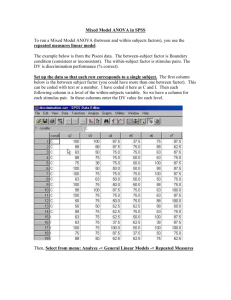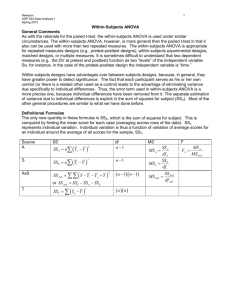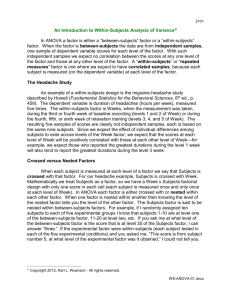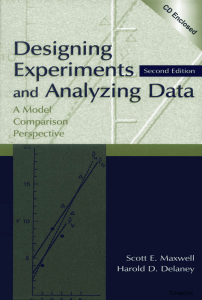Within-Subjects
advertisement
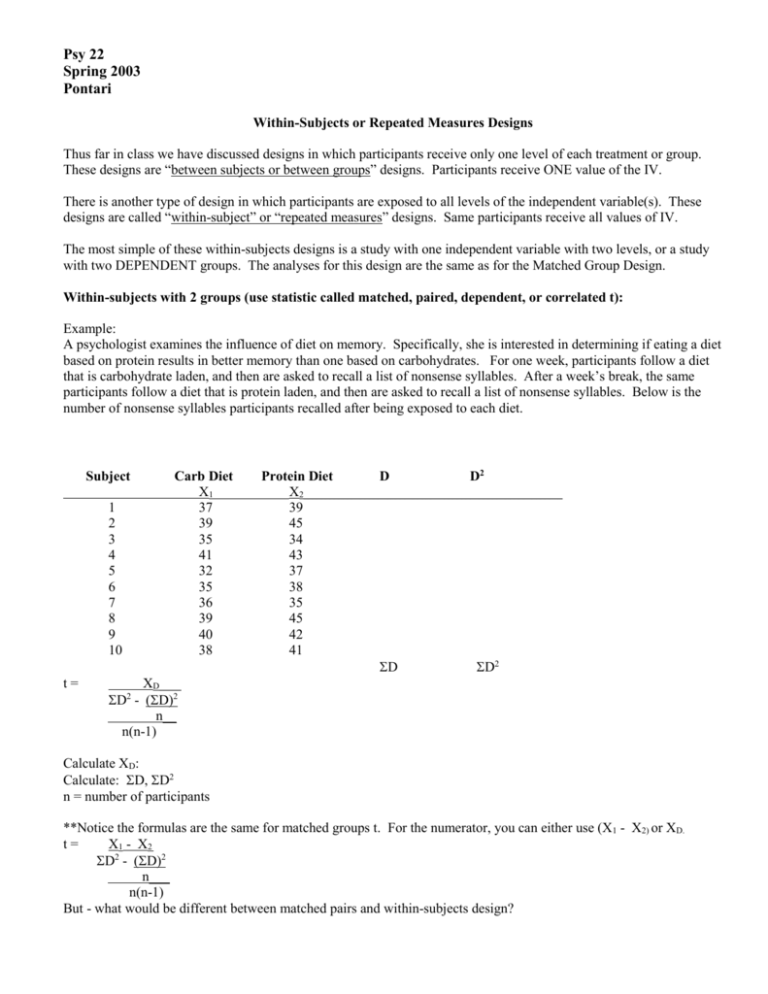
Psy 22 Spring 2003 Pontari Within-Subjects or Repeated Measures Designs Thus far in class we have discussed designs in which participants receive only one level of each treatment or group. These designs are “between subjects or between groups” designs. Participants receive ONE value of the IV. There is another type of design in which participants are exposed to all levels of the independent variable(s). These designs are called “within-subject” or “repeated measures” designs. Same participants receive all values of IV. The most simple of these within-subjects designs is a study with one independent variable with two levels, or a study with two DEPENDENT groups. The analyses for this design are the same as for the Matched Group Design. Within-subjects with 2 groups (use statistic called matched, paired, dependent, or correlated t): Example: A psychologist examines the influence of diet on memory. Specifically, she is interested in determining if eating a diet based on protein results in better memory than one based on carbohydrates. For one week, participants follow a diet that is carbohydrate laden, and then are asked to recall a list of nonsense syllables. After a week’s break, the same participants follow a diet that is protein laden, and then are asked to recall a list of nonsense syllables. Below is the number of nonsense syllables participants recalled after being exposed to each diet. Subject 1 2 3 4 5 6 7 8 9 10 t= Carb Diet X1 37 39 35 41 32 35 36 39 40 38 Protein Diet D D2 X2___________________________________________________________ 39 45 34 43 37 38 35 45 42 41 D D2 XD_____ D2 - (D)2 n__ n(n-1) Calculate XD: Calculate: D, D2 n = number of participants **Notice the formulas are the same for matched groups t. For the numerator, you can either use (X1 - X2) or XD. t= X1 - X2 D2 - (D)2 n___ n(n-1) But - what would be different between matched pairs and within-subjects design? Does a protein diet result in better memory than a carbohydrate diet? Must see if you can reject the null. Need to determine tcrit - use the t-table. Alpha: .05 Df = N - 1 (where n - the number of subjects) tcrit = Should the psychologist reject the null? What should she conclude then? Write out her results in APA format. Within-subjects with more than 2 groups (within-subjects or repeated measures ANOVA): There are many other types of within-subjects designs. For example, a researcher can manipulate one independent variable with several (more than 2) groups or levels. Every participant would be exposed to each level of the independent variable. Example (from McGuigan): A researcher is interested in studying the effects of story-length in the processing of information. Each participant is exposed to four different story lengths and is then asked reading comprehension questions about each story. Below are the participants’ scores on each of the 4 reading comprehension tests. Subject# 1 2 3 4 5 6 7 Story1 4 14 6 11 7 10 9 X1: X12: Story2 2 7 6 3 5 4 4 X2: X22: Story3 8 5 6 8 7 8 8 X3: X32 : Story4 3 13 10 4 5 9 7 X4: X42: S As in a between-subjects design with one IV with more than 2 levels, an ANOVA will be utilized to analyze the data. The analysis follows the same procedures as we have used with designs with more than 2 groups. You will calculate: Sums of Squares, Degrees of Freedom, Mean Squares, and finally F-ratios. There are a few differences when analyzing data for a within-subjects design. Previously, we would calculate SS, Df, and Mean Square for between, within, and total. For within-subjects ANOVA, we calculate SS, DF, and Mean Square for between conditions or groups, between subjects, within (or error), and the total. The “between subjects” is a new feature of the analysis. (Note: your book calls between conditions and subjects “among” condition and subjects). 1. Sums of Squares Total (this is the SAME formula we used for SStotal for One-Way ANOVA): But N in this case is: (the number of participants) x (number of conditions or groups). N= Between (among) conditions (this is the SAME formula we used for SSbetween for One-Way ANOVA): Between (among) subjects (this is a NEW FEATURE of this analysis - uses new term: S): K = number of conditions (groups or levels). K= 1. Sums of squares, continued: Error: (In analyses with between subjects designs, we referred to this SS as SSwithin. Recall that SSwithin is what eventually creates the denominator of the F-ratio, and also relates to error variance. In within-subjects designs, using the “within” label can be misleading or confusing, and therefore, this SS is referred to as SSerror). To calculate, simply apply: SStotal = SSbetcond - SSbetsubj - SSerror As in previous analyses, SS is affected by number of subjects (more subjects – higher SS). To calculate variance, we need to divide by degrees of freedom. 2. Degrees of Freedom: Total = N-1 Between conditions = K - 1 (where K = number of groups) Between subjects = n - 1 (where n = number of subjects) Error = (K - 1)(n-1) 3. Mean Square (Variance) MSbetweencond = SS betweencond Df betweencond MSbetweensubjs = SS betweensubjs Df betweensubjs MSerror = SS error Df error Source of variance Sums of Squares SS Between conditions Between subjects Error TOTAL df Degrees of Freedom (K - 1) (n - 1) (K-1)(n-1) (N - 1) Mean Squares (Variance) F ratio 4. F-ratio Calculate F for between conditions and between subjects (still the same conceptually and computationally). Conceptually: F = variance between groups variance within groups Computationally: Fbetweencondit = MSbetweencondit MSerror Fbetweensubjs = MSbetweensubjs MSerror Is there a significant effect of story condition (should you reject the null)? Fcrit = What can we conclude about the differences between the 4 groups? To determine which groups differ, you would have to do pairwise comparisons using t-tests (and possibly apply the Bonferroni procedure, or only do r-1 comparisons). What do you think the F for between subjects is testing? Is there a significant effect for subjects (should you reject the null)? Fcrit = Would we want this to be significant? In essence, with this within-subjects or repeated measures ANOVA, we tested two null hypotheses: H0 = There are no differences in the population means of the 4 groups. H0 = There are no differences in the means of the 7 subjects. New and important assumption about within-subjects or repeated measures ANOVA: That there is no significant interaction between the condition and subject variables.
